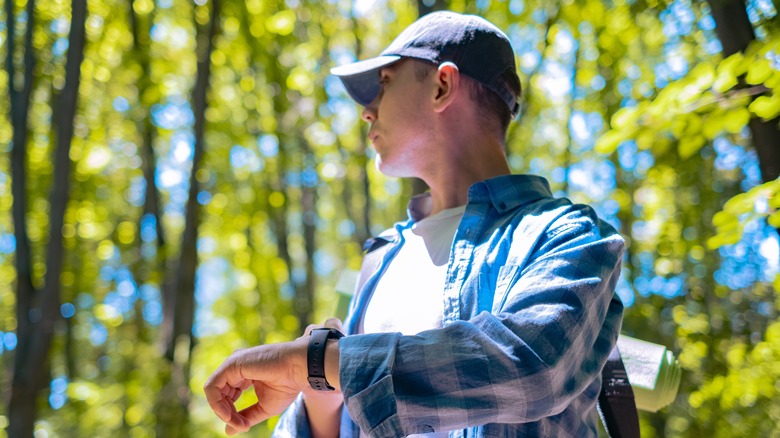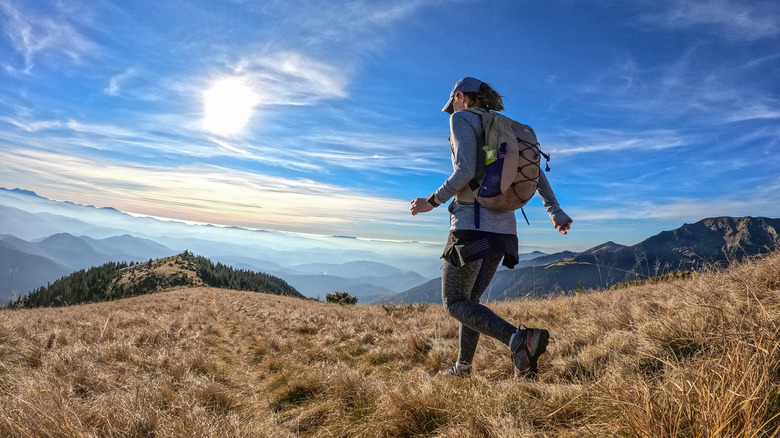'Rucking': What Is It And How Does It Transform Your Body?
You've seen the hashtag #goruck on TikTok. Or maybe you haven't. CrossFitters will include rucking as part of their WOD (workout of the day) or an additional workout to keep them fit. GQ loves rucking so much that it named rucking the workout of 2024.
Rucking comes from the military. Army ROTC (Reserve Officer Training Corps) cadets must complete a 12-mile ruck march carrying 35 pounds of equipment — including a rifle. Rucking for civilians isn't quite so extreme. Male CrossFitters might add 20 pounds to their weighted vests while females add 14 pounds, and a 12-mile run isn't in their plan. Sometimes they'll go rucking for a mile then complete 50 squats and 25 push-ups — and then repeat.
You also don't have to be into CrossFit to be a rucker. Some people will just stuff books, bricks, or weighted plates into a backpack and go for a walk. When you think about it, you're probably already rucking if you've ever carried a heavy load on your back around town, an amusement park, or an airport. The added weight on your body can help you build muscle, and you might also find that rucking can improve your posture.
Rucking improves cardiovascular and muscular fitness
If you've ever carried a heavy backpack, you might notice that the backpack itself helps to pull your shoulders back so you're standing with better posture. The added weight makes it more difficult to hunch forward because it throws you off your balance. Rucking helps you walk more efficiently while creating more stability in your shoulders. You'll also be strengthening the muscles in your back, core, legs, and glutes.
Running with a weighted vest can also improve your cardiovascular system, according to a 2022 article in Ergonomics. People who ran with a weighted vest on a treadmill had a 7% higher heart rate and required more oxygen to sustain their run. They also said it made the running harder. Running with a weighted vest also caused them to burn more calories. Because their heart rate was higher, they burned more carbohydrates but less fat during their workout.
Exercising with a weighted vest is also good for older adults to prevent age-related muscle loss. In a 2018 study in the Journal of Clinical Medicine, 11 women aged 65 to 74 took part in a step exercise program while wearing added weights three days a week for six weeks. They improved the power in their legs by as much as 11%, which helped them to climb stairs 9% faster.
How to start rucking
If you want to try rucking, you probably don't need to go to a store. Any backpack will do, although the extra straps and padding on a hiking backpack might make it easier to carry the heavy loads for longer distances. Some backpacks are specifically designed for rucking and even have weighted plates to fit easily in the pack. If you're using dumbbells, books, or bricks, be sure to wrap them in towels or other types of padding so they don't pinch your back. It also helps if you can keep the weight higher on your back.
Although the amount of weight you'll use depends on your fitness, GoRuck suggests starting with 10 to 20 pounds if you can walk a mile in less than 20 minutes. You'll use less weight if it takes you longer to walk a mile. Your first workout can be a 2.5-mile walk at 17 to 20 minutes per mile. For the next week, try for 3 miles. Do only one workout per week for the first two weeks, especially if you're somewhat new to fitness. You can gradually progress to two workouts a week and start power walking.
Because many people are used to hunching their shoulders due to sitting at their desks or pecking at a smartphone, be mindful of your posture and balance when you start rucking. It might feel awkward at first as your body gets used to the distribution of weight on your body.


